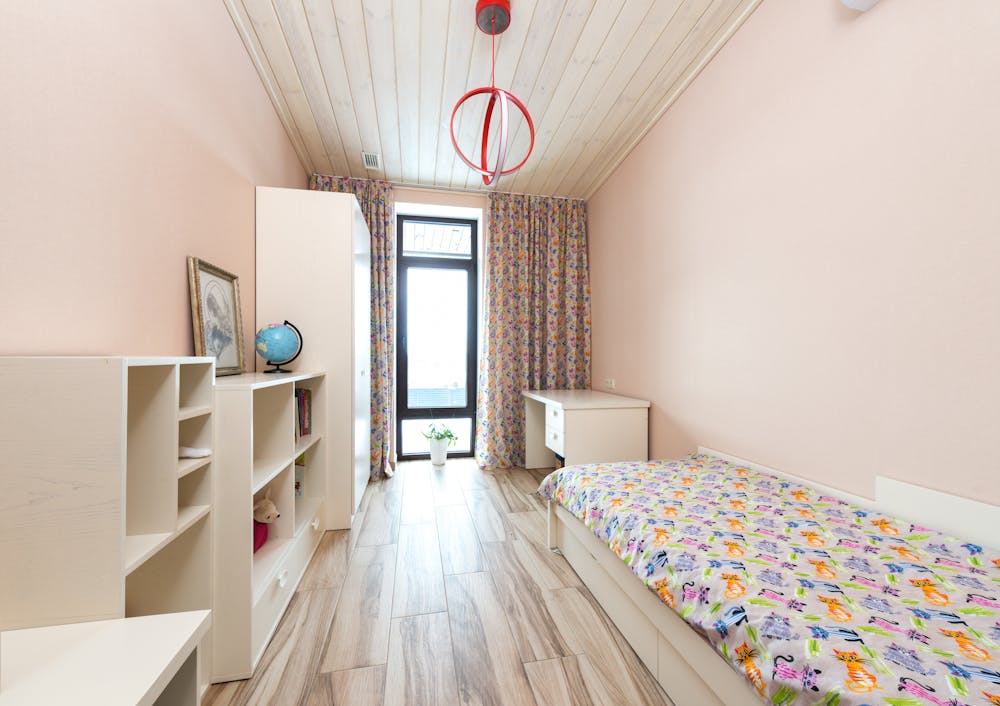A single bed can revolutionize your bedroom’s functionality, especially in smaller spaces. Opting for a single bed allows you to maximize floor space while creating a cozy sleeping area. This choice opens up possibilities for adding other furniture pieces or creating dedicated zones for work, relaxation, or storage.
Single beds come in various styles and designs to suit different needs. From sleek platform beds to space-saving ottoman beds with built-in storage, there’s an option for every room layout and personal preference. Some models even feature pull-out trundles or fold-out desks, further enhancing the room’s versatility.
By choosing a single bed, you’re not sacrificing comfort for space. Many adult single beds offer ample sleeping room while allowing for a more organized and efficient bedroom layout. This approach can lead to a calmer, less cluttered environment conducive to better sleep and overall well-being.
Key Takeaways
- Single beds maximize space without compromising comfort
- Various styles offer additional functionality like storage or work areas
- A well-chosen single bed can create a more organized and efficient bedroom
Maximizing Space with Smart Single Bed Choices
Single beds offer creative solutions for optimizing bedroom layouts. The right design can dramatically enhance functionality and storage while maintaining style and comfort.
Choosing the Right Single Bed Design
Single beds typically measure 36 x 75 inches or 39 x 75 inches, providing ample sleeping space without overwhelming smaller rooms. Custom-sized options allow for precise fitting in unique spaces. Upholstered single beds add a touch of elegance and can serve as focal points.
Canopy designs create visual interest and define sleeping areas in multi-purpose rooms. Daybeds offer versatility, functioning as seating during the day and beds at night. This dual-purpose approach is especially valuable in studio apartments or guest rooms.
When selecting a design, consider the room’s overall aesthetic and how the bed will complement existing decor. Opt for styles with clean lines and minimal footprints to maintain an open feel.
Innovative Single Bed Features for Storage
Built-in storage features transform single beds into organizational powerhouses. Many designs incorporate drawers directly into the bed frame, providing discreet space for clothing, linens, or seasonal items.
Headboards with integrated shelving offer convenient spots for books, alarm clocks, and decorative items. Some models feature hidden compartments within the headboard for valuable or personal belongings.
Ottoman-style beds with lift-up mattress platforms reveal spacious storage areas underneath. This design is ideal for storing bulky items like extra bedding or out-of-season clothing.
• Drawer systems • Shelving headboards • Lift-up platforms
Leveraging Vertical Space and Under-Bed Areas
Maximizing vertical space is crucial in compact bedrooms. Loft-style single beds elevate the sleeping area, freeing up floor space beneath for desks, dressers, or seating areas. This arrangement creates distinct zones within the room.
Under-bed storage solutions come in various forms. Rolling bins or baskets offer easy access to frequently used items. Vacuum-sealed bags can compress bulky bedding or clothing, maximizing available space.
Some single bed designs feature built-in staircases or ladders with integrated drawers or cubbies. This clever use of typically wasted space adds both functionality and visual interest to the room.
Creating a Cohesive Bedroom Layout and Decor
A well-designed single bedroom balances functionality and style. Thoughtful space planning, versatile furnishings, and harmonious decor create a comfortable retreat that maximizes every square metre.
Crafting Distinct Zones in a Single Bedroom
Divide the room into purposeful areas to enhance functionality. Place the bed against the longest wall to anchor the space. Create a cozy reading nook near a window with a comfy armchair and small side table. Designate a work zone by positioning a compact desk and chair in a quiet corner.
Use area rugs to visually separate zones without walls. A plush rug under the bed defines the sleeping area, while a smaller rug can delineate a seating space. Arrange furniture to allow easy traffic flow between zones.
Consider a folding room divider or open shelving unit to provide subtle separation between sleep and work areas in smaller rooms.
Incorporating Multi-Functional Furniture and Seating
Opt for innovative, space-saving pieces that serve multiple purposes. A Murphy bed with a built-in desk offers flexibility, transforming from sleeping quarters to a home office. Choose a storage ottoman that doubles as extra seating and a place to stow blankets or clothing.
Look for nightstands with drawers or shelves to maximize storage. A bench at the foot of the bed provides seating and a spot to place clothes or bags. Consider a daybed that functions as both seating and a guest bed when needed.
Foldable or nesting tables can be tucked away when not in use, creating more floor space during the day.
Selecting Colour Schemes and Lighting for Ambience
Choose a cohesive colour palette to unify the space. Opt for light, neutral wall colours to make the room feel more spacious. Add pops of colour through bedding, artwork, and accessories for visual interest.
Incorporate layered lighting for versatility. Install a dimmer switch on the main ceiling fixture for adjustable overhead lighting. Add task lighting near the desk or reading area with a sleek table lamp. String fairy lights above the bed for a soft, ambient glow.
Use mirrors strategically to reflect light and create the illusion of more space. A large mirror opposite a window can brighten the entire room.
Conclusion
Single beds offer a practical solution for creating a more functional bedroom. Their compact size maximizes floor space while still providing comfortable sleeping arrangements. These beds integrate seamlessly with various storage options, enhancing organization and reducing clutter.
By choosing a single bed, individuals can optimize their bedroom layout, allowing for additional furniture or activity areas. This versatile choice supports a well-designed, efficient living space tailored to one’s specific needs and lifestyle.
